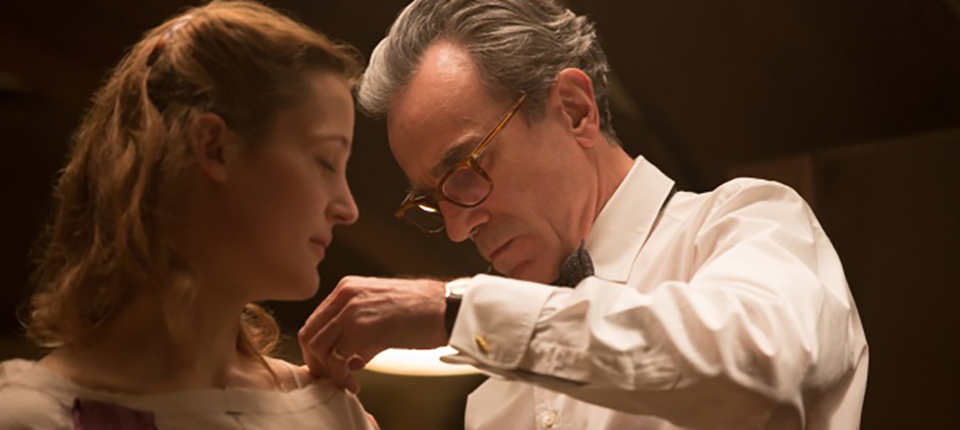Not often does a film score stand out as a work of art independent of the movie it embellishes, but there are the rare exceptions. Everyone remembers the zither tune in The Third Man, Howard Shore’s ominous counterpoint clocks in After Hours, or Stanley Kubrick’s counterintuitive needle drops in 2001: A Space Odyssey. Other scores meet the film on a plane in which the photography and music cannot be disentangled: Ryuichi Sakamoto’s title cue for The Last Emperor; Jerry Goldsmith’s recurring, melancholy muted-trumpet line in Chinatown; Philip Glass’s winding synth fractals heard over a time-lapsed New York City in Koyaanisqatsi.
Jonny Greenwood’s score to Phantom Thread—Paul Thomas Anderson’s movie about a maniacally fussy dressmaker named Reynolds Woodcock—is of the latter type. The music has a sinewy, ductile curvature that folds itself into the piles of fabric, weaving its way into the lining as the cloth becomes a dress. The main theme is a tense piece played by a string section in its upper register, where things cease to sound sweet and become eerie and diaphanous. Other cues are full of wide, warm major-ninth chords that flutter around like pastel ribbons. There are voicings that remind one of Bill Evans at his most fragile; instrumental color that brings to mind the Ballet Russes; airy chromaticism à la Miles Davis circa Nefertiti. Solo piano lines pick out patterns in the music like animate glowing lace. All of it is impeccably recorded. It is perverse that it didn’t win the Oscar for best score this year.
Greenwood’s score is not background music. It is right up front, and it drives the film. Phantom Thread is in this way almost closer to some form of opera. And there is a lot of music—almost ninety minutes of score in a film just over two hours. The sound is the texture of the film. The different timbres are like different fabrics; the viola feels different from the piano in the same way linen feels different from silk. And near wall-to-wall music means that the few sustained stretches of silence gather dramatic weight.
Not all the music in Phantom Thread is Greenwood’s. Oscar Peterson plays the Kurt Weill tune “My Ship.” There are snippets of the second movement of Debussy’s string quartet, full of spiky pizzicato figures. (I was relieved that this was not the second movement of Ravel’s quartet since the Ravel has in recent years become so ubiquitous that it has begun to sound like a Volvo commercial.)
The sound design in Phantom Thread is nearly as central as the music. The young woman who becomes Woodcock’s model and muse, Alma, is also a sort of reverse muse. She prods and irritates his fastidious hypersensitivity. During one scene at the breakfast table, the sound of Alma scraping a knife across her toast (there is much clattering of cutlery in the film) is so obscenely vivid in the sound design that it becomes clear we are hearing it from Reynolds’s perspective. He tells her that the knife across the toast is like a horse riding through the room and finally issues the verdict that there has been “entirely too much movement at breakfast.”
When the film takes a Hitchcockian turn involving poisonous mushrooms, we expect the score to gesture to Hitchcock’s composer Bernard Herrmann. But Greenwood stays true to the musical language he and Anderson have been evolving for years: the sweeping romanticism of huge string sections, smaller motifs that rotate inside the strings like glittering cogs, and a coarse resonating feedback that sometimes creeps up behind the orchestra, versions of which Greenwood used to accompany the effects of different drugs in Inherent Vice. The mushroom toxins seeping into Woodcock’s bloodstream could be heard in these thin acidic striations of feedback.
The music in Phantom Thread gives us access to interior processes—both psychological and biological—that a camera could never capture. The collective intensity of the seamstresses working day and night on a dress occurs in a musical atmosphere that turns the tension of a deadline into its own kind of cold beauty. When Woodcock is apparently on the brink of death, his vision of his mother—the film’s one actual phantom—is inhabited by that eerie upper register in the strings, as if the sound were accessing something supernatural. After Reynolds and Alma reluctantly wed, their shaky matrimonial bliss is scored to laterally drifting piano figures that, like snowflakes, are pretty but ephemeral and brief. When Alma heads out in search of a party on New Year’s Eve, the revelers’ collective “Auld Lang Syne” is taken over by a blurry, disoriented orchestra as Woodcock appears and stumbles around in search of his wife.
This is Greenwood’s first Oscar nomination. He lost the award to Alexandre Desplat, for The Shape of Water, but this seems fitting for a film so explicitly about the sacrifices required for art. Phantom Thread will last long after the buzz of an awards show has been forgotten; its intensity and vividness will matter to people in ways the parade of dresses on the red carpet cannot. (If only a few of them had been designed by Reynolds!) I believe it will become one those scores, like Sakamoto’s Last Emperor or Herrmann’s Vertigo, that people will remember independent of the movie, as music that stands on its own. In any case I have just ordered the Phantom Thread CD and look forward to playing it while scraping hummus over my toast.
Paul Grimstad’s original scores and songs may be heard in Thirst Street, Heaven Knows What, Happy Christmas, Frownland, and other films.
from The Paris Review http://ift.tt/2D0f34k

Comments
Post a Comment